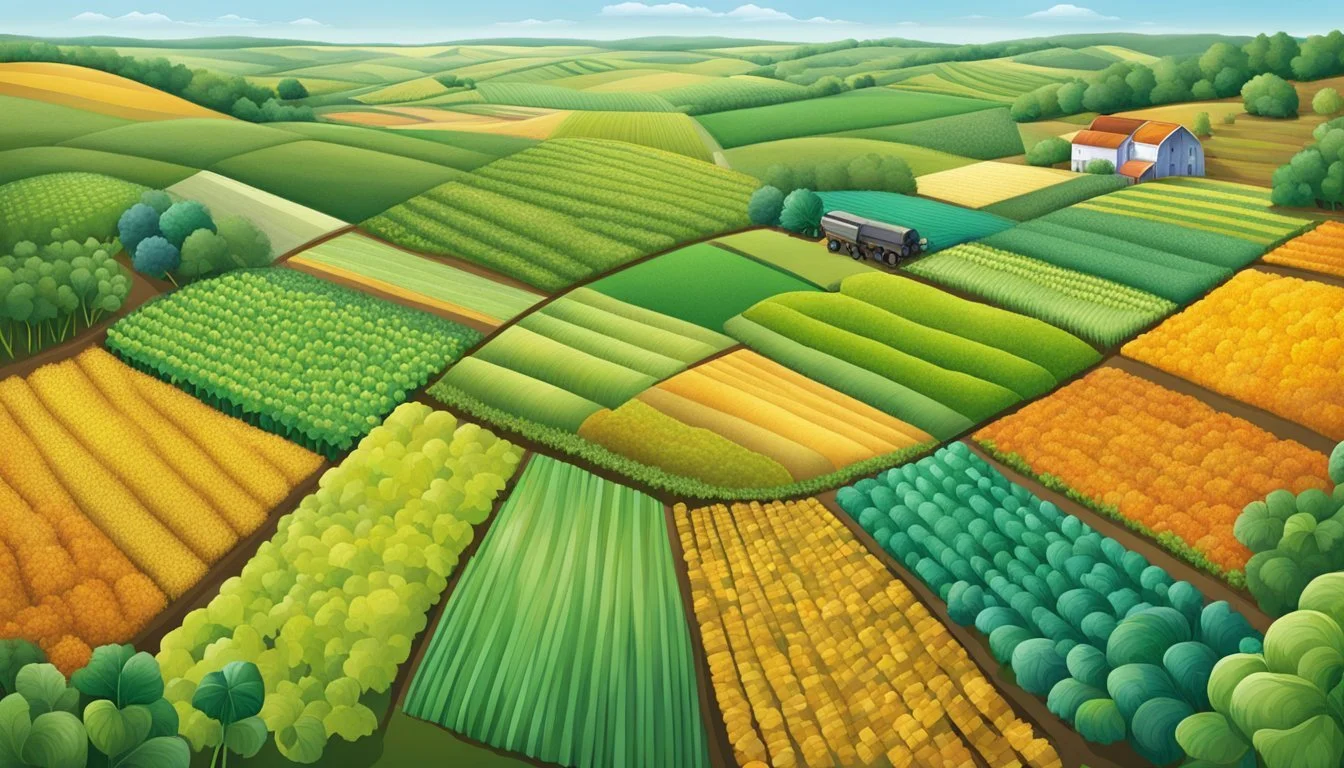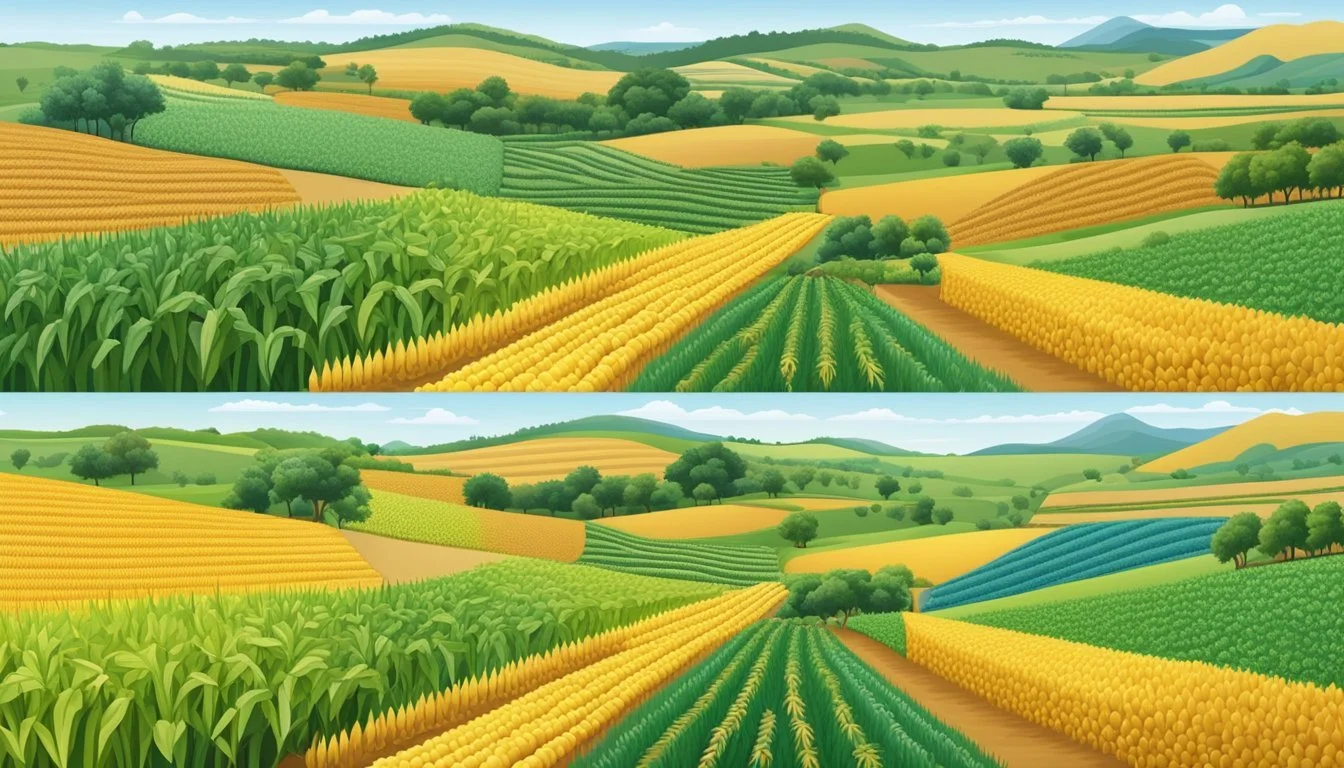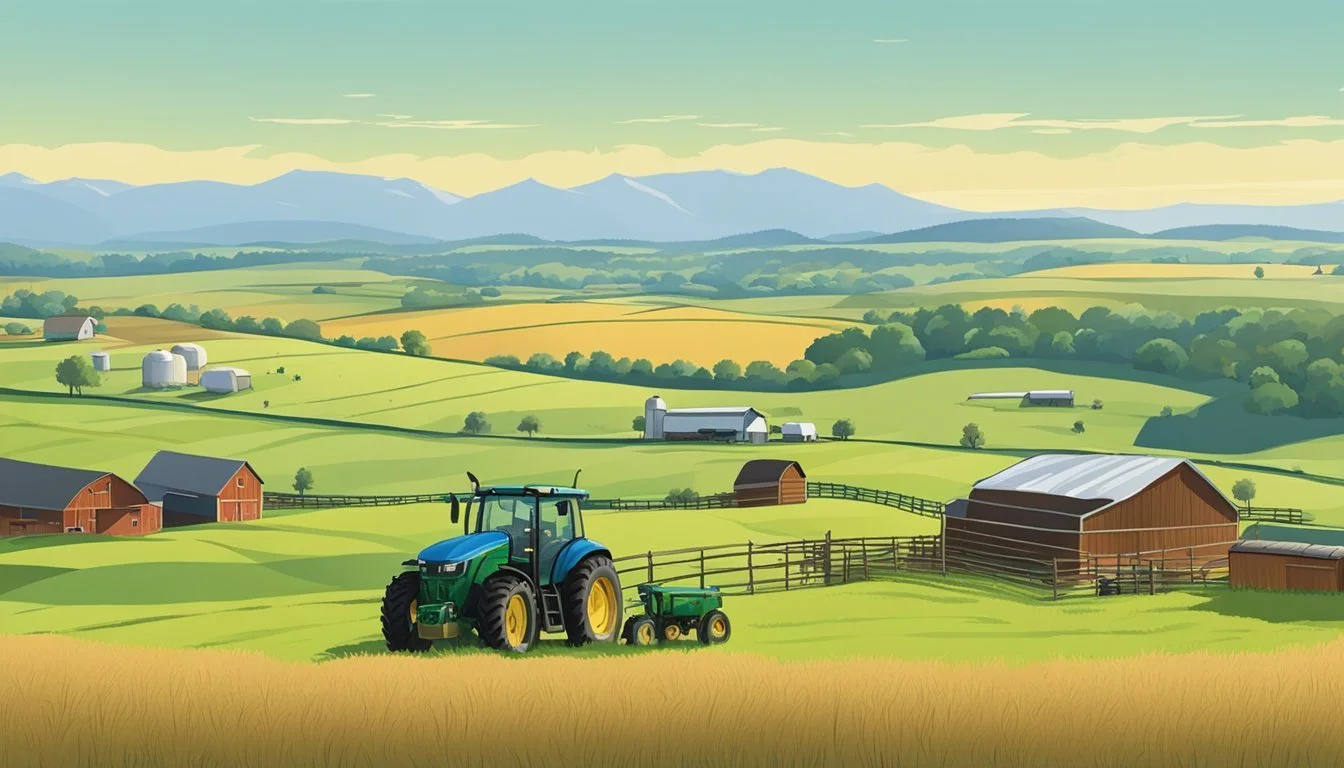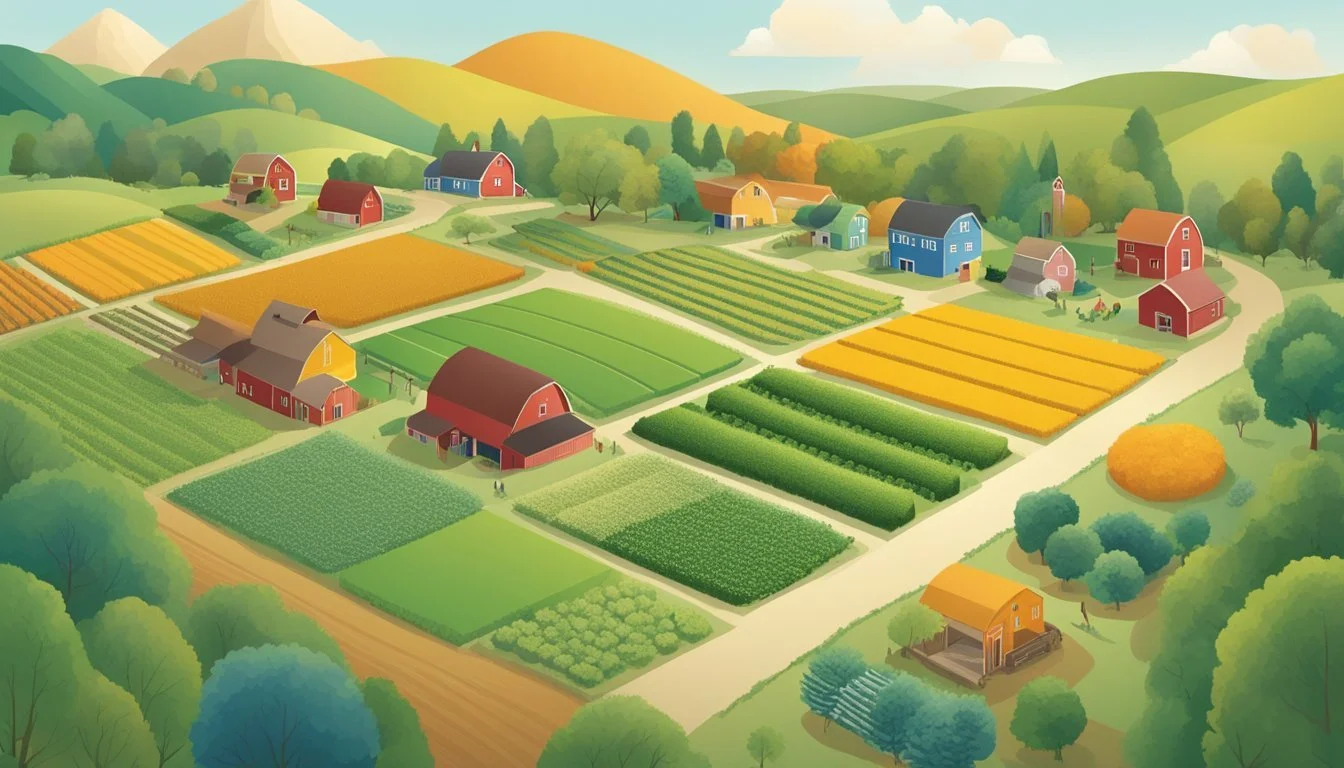State by State Farming Guide
Optimize Your Agricultural Practices
Agriculture forms the backbone of the American economy, with each state contributing to the mosaic of national food production in a distinct way. From sprawling wheat fields in the Midwest to the wide variety of fruits and vegetables grown in California's fertile valleys, farming practices and outputs vary widely across the United States. Providing a state-by-state farming guide allows individuals and entities interested in agriculture to understand the unique role each state plays in the national agricultural landscape.
The diversification of crops, climate conditions, and farming techniques are shaped by geographic, economic, and cultural factors, resulting in a patchwork of agricultural production. Some states are known for leading in cash crops like corn, soybeans, (how long do soybeans last?) and cotton, while others specialize in dairy, poultry, or beef. Characteristics of the land, such as soil types and climate, guide farmers' decisions and form the basis for regional agricultural economies.
Understanding specific agricultural contributions and practices on a state-by-state basis is essential for anyone in the farming industry. Such knowledge aids in making informed decisions for agricultural investments, operations, and policy-making. It also informs consumers and businesses about where their food comes from, and which states are leaders in the various sectors of agricultural production.
Starting a Farm State by State
Embarking on a farming venture is an exciting endeavor that varies widely across the United States. Each state offers unique opportunities, challenges, and resources tailored to aspiring farmers. From the sun-kissed orchards of California to the rolling pastures of Vermont, understanding the local landscape, climate, and market is crucial. Our comprehensive guide provides state-specific insights to help you navigate the agricultural tapestry of America. Whether you're considering crop selection, seeking financial assistance, or exploring sustainable practices, this article is your first step towards a bountiful farming journey in whichever state your heart and land may lie.
Understanding The Agricultural Landscape
Agricultural practices and land use vary significantly across the United States, shaped by climate, soil quality, and state-specific regulations. Insight into this diversity is crucial for anyone involved in the agricultural sector.
Overview of US Agriculture
The United States is a global agricultural powerhouse, leveraging a wide range of climates and soils to produce a vast array of crops and livestock. States like Iowa and Illinois are renowned for corn and soybean production, thanks to their fertile soil and ample growing season. In contrast, states like California have a diverse agricultural output, from fruits and vegetables to nuts and dairy, enabled by a variety of microclimates.
State-Specific Farming Profiles
Each state's farming profile is shaped by its location, climate, and soil types. For example:
California: Dominant in fruits, vegetables, nuts, and dairy.
Iowa: A leader in corn, soybeans, and pork.
Texas: Notable for cattle, cotton, and poultry.
These profiles have implications for both local economies and the broader food supply chain.
Climate Impact on Farming
Climate plays a pivotal role in determining suitable crops and farming practices. States that experience drought conditions, such as those in the Southwest, adapt by focusing on drought-resistant crops or employing advanced irrigation methods. Alternatively, states with ample rainfall, like those in the Pacific Northwest, support lush farmland ideal for a variety of crops.
Soil Types and Land Quality
The quality of farmland in the United States is as varied as its climate:
Loamy soil: Found in the Midwest, it's ideal for corn and soybeans.
Arid soil: In the Southwest, it requires irrigation for farming.
Volcanic soil: In Hawaii, it's rich and supports tropical agriculture.
Maintaining soil quality through sustainable practices is vital for long-term agricultural productivity.
Key Crops and Farming Practices
The diversity of crops and farming practices across the United States is vast, with each state presenting its own combination of preferred crops and agricultural methods. This section aims to dissect the main crops and associated farming practices prevalent in different regions, offering a concise overview of America's farming landscape.
Corn and the Corn Belt
The Corn Belt is a region primarily consisting of Iowa, Illinois, Indiana, southern Michigan, western Ohio, eastern Nebraska, eastern Kansas, southern Minnesota, and parts of Missouri. Here, corn is the predominant crop, with farming practices focused on high-yield hybrids and advanced technologies in precision agriculture to manage large-scale operations effectively.
States: Iowa, Illinois, Indiana, and others
Practices: Precision agriculture, high-yield hybrids
Wheat Farming Nuances
Wheat thrives in the Great Plains, also known as the "Breadbasket of the World," which includes Kansas, Nebraska, Oklahoma, and parts of Texas. Hard red winter wheat is common, and farmers employ crop rotation and conservation tillage to maintain soil health and productivity.
States: Kansas, Nebraska, Oklahoma
Practices: Crop rotation, conservation tillage
Soybeans and Oil Crops
Soybeans are predominantly cultivated in the Midwest, overlapping with the Corn Belt. These oil crops benefit from similar advancements in farming technologies, with a focus on genetic modification for pest and herbicide resistance and soil fertility management.
States: States within the Corn Belt
Practices: Genetic modification, soil fertility management
Specialty Crops and Vegetables
Diverse climates across states like California and Florida support a wide range of specialty crops and vegetables, such as almonds, tomatoes, and citrus fruits. These often require more labor-intensive practices and controlled environments to ensure quality produce.
States: California, Florida
Practices: Controlled environments, labor-intensive methods
Cotton and Textile Agriculture
Southern states, notably Texas, Georgia, and Mississippi, are key players in cotton production. Precision agriculture is also crucial here, alongside practices like irrigation management and pest control strategies to maintain the quality of this textile crop.
States: Texas, Georgia, Mississippi
Practices: Irrigation management, pest control
Livestock and Ranching Dynamics
Ranching in the United States is a robust industry, with specific states leading primarily due to their extensive resources and supportive environments. Each subsection here examines different aspects of livestock dynamics, focusing on the major ranching and farming activities.
Beef Cattle Rearing
Montana, Texas, Nebraska, Kansas, and Wyoming are foremost in beef cattle ranching. These states offer vast pasturelands suitable for cattle grazing, with Montana often leading due to its abundant natural resources and strong community support for agriculture. In Texas, ranchers managing extensive herds benefit from the state's significant land area and favorable climate.
Texas: Largest in land size and herd numbers
Montana: Ranked highest for environment and support systems
Poultry and Dairy Production
Missouri and Ohio are notable for their poultry and dairy production. These states combine for a robust environment that supports the growth of these sectors. Missouri, with a significant number of farms, focuses on both poultry and dairy, contributing greatly to the state's farming income through diverse livestock operations.
Missouri: High number of farms with intensive poultry and dairy activities
Ohio: Recognized for efficient poultry and dairy farming methodologies
Sheep, Horses, and Alternative Livestock
Sheep farming is present across several states, while horse ranching is embedded in state cultures like Wyoming and Texas. These states provide suitable environments for grazing and ranch operations. Alternative livestock such as bison and alpaca also contribute to the diversity of ranching activities with various states adapting to niche markets in livestock farming.
Wyoming: Known for horse ranching traditions
Texas: Supports a diverse range of livestock rearing, including horses and sheep
State-By-State Guide
This section provides an overview of agricultural practices, highlighting distinctive farming characteristics and prominent crops in varying regions across the United States.
Midwest Farming: Iowa to Ohio
The Midwest, often referred to as the "Corn Belt," is a powerhouse for corn and soybean production. In Iowa, agriculture is a driving economic force with corn being the top crop, while soybeans are also significant. Moving into Illinois and Indiana, the trend continues with these states being leading producers of both corn and soybeans. Ohio diversifies its agriculture with dairy farming and egg production alongside its grain crops.
Iowa: Corn, Soybeans
Illinois: Corn, Soybeans
Indiana: Corn, Soybeans, Dairy, Eggs
Ohio: Soybeans, Dairy, Eggs
Southern States: Texas to Florida
The South offers a variety of crops due to its warm climate and extended growing seasons. Texas leads with its vast cattle ranches and cotton fields. In Florida, the humid climate is perfect for citrus fruits, especially oranges. Conversely, Arkansas and Tennessee are known for rice and soybean production, with Arkansas ranking first in the nation for rice farming.
Texas: Cattle, Cotton
Florida: Citrus
Arkansas: Rice, Soybeans
Tennessee: Soybeans, Cotton
Western Agriculture: California to Oregon
California is an agricultural giant, leading in fruits, vegetables, and nuts, including almonds, strawberries, and lettuce. Moving north to Oregon, the cooler climate is favorable for wheat and potatoes, with the state also known for its nursery products.
California: Fruits, Vegetables, Nuts
Oregon: Wheat, Potatoes, Nursery products
Eastern Traditions: New York to Georgia
New York, with its rich soils and temperate weather, excels in dairy production and apples. Pennsylvania's farming is diverse, known for its mushrooms, dairy, and cereals. Heading south to Georgia, the state is famous for its peaches and poultry.
New York: Dairy, Apples
Pennsylvania: Mushrooms, Dairy, Cereals
Georgia: Peaches, Poultry
Unique Climates: Alaska and Hawaii
Alaska and Hawaii, despite their geographic differences from the contiguous states, contribute uniquely to American agriculture. Alaska's agriculture is limited but includes barley, oats, and potatoes, while Hawaii's tropical climate supports crops like sugarcane, pineapples, and coffee.
Alaska: Barley, Oats, Potatoes
Hawaii: Sugarcane, Pineapples, Coffee
Agricultural Business and Economics
Agricultural business and economics are pivotal for farmers and farm businesses, focusing on financial performance, investment opportunities, and market strategies.
Starting and Managing a Farm Business
When starting and managing a farm business, understanding the financial characteristics and performance indicators is crucial. A farmer should be aware of current estimates and forecasts of farm income, expenses, asset values, and debt. This knowledge helps in making informed decisions regarding the farm's structure and organization.
Key Areas of Focus:
Estimating initial capital requirements.
Understanding ongoing operational costs.
Budgeting for labor, interest rates, energy, and fertilizer costs.
Implementing efficient farm organization and management practices.
Support and Investment for Farmers
States often provide various business incentives to support the agricultural sector. These can include loans, grants, or tax credits. Such incentives aim to grow and diversify the agricultural sector, encourage the adoption of efficient technologies, and reduce entry barriers for beginning farmers.
Types of State Support:
Financial incentives: Loans and grants.
Tax incentives: Credits and rebates.
Support for technology adoption: Funds for modern farming equipment.
Marketing and Selling Agricultural Products
Farmers engage in marketing and selling agricultural products to generate revenue. They may benefit from the vast array of publications and statistics that guide pricing and market trends. Additionally, state agricultural agencies can serve as fact-finders to assist in the strategic selling of products.
Marketing Strategies:
Utilize data on traditional and specialty crops for pricing.
Analyze market trends for various agricultural products.
Selling Tactics:
Establish relationships with local and regional markets.
Explore direct-to-consumer sales channels.
Governmental Support and Regulations
The landscape of agricultural support in the United States is a complex network of federal and state regulations and programs designed to support farmers and ensure sustainable farming practices. These initiatives range from financial support to technical assistance and are crucial for the vitality of the agricultural sector.
USDA Programs and Assistance
The U.S. Department of Agriculture (USDA) offers numerous programs aimed at assisting farmers. From financial support through loans and grants to technical advice and market development, the USDA is a pivotal entity for farm aid. Notably, the Farm Bill encompasses various provisions for commodities, conservation, and crop insurance, to name a few.
Farm Loans: to aid in purchasing land or finance agricultural operations
Disaster Assistance Programs: to recover from crop losses due to natural disasters
Conservation Programs: offering technical and financial support to implement sustainable practices on farms
State-Level Agricultural Policies
Individual state governments exert broad regulatory powers to enact innovative programs that protect farmland. They develop policies that can include:
Legal tools such as state laws, ordinances, and executive orders: specifically to protect farms and ranches
Support systems to help farmers access land and financial resources
State-specific regulations, such as the prohibition of certain confinement practices in farm animal welfare.
Legislation Impacting Farming
Legislation, such as the National Pollutant Discharge Elimination System (NPDES) and state welfare laws, shapes the farming industry significantly.
The NPDES Concentrated Animal Feeding Operation Rule: requires large CAFOs that land apply manure to adhere to nutrient management plans and obtain permits if discharges to U.S. waters occur.
Animal Welfare Acts: Several states have passed legislation that influences the standards of welfare in livestock production, prohibiting sales from non-compliant operations and banning specific confinement practices.
Research, Data, and Trends
In the realm of agriculture, robust research, meticulous data analysis, and the observation of trends over specific time periods illuminate the ever-evolving landscape of farming across the states.
Agricultural Research Priorities
Research plays a fundamental role in advancing agricultural practices and technologies. Priorities vary by state, with California focusing on sustainable water usage due to its dry climate, and Iowa prioritizing corn and soybean genetic improvement for yield enhancement. Texas A&M AgriLife Research, for example, is dedicated to innovations in areas such as beef cattle production and pest management.
Data Analysis and Reporting
Data analysis and reporting are pivotal for tracking progress and making informed decisions in agriculture. The USDA's Agricultural Statistics Service provides comprehensive data, including cash receipts by commodity for each state from the period of 2008-2023. This allows for a granular look at financial indicators such as net income. For instance:
Iowa's Net Income (in billions):
2018: $3.1
2022: $3.2
Washington's Top Commodities (in billions):
Apples: $2.0
Trends Over Time
Identifying trends over time gives stakeholders insight into the flux of agricultural success and challenges. The USDA Census of Agriculture, conducted every five years, has revealed significant trends like the gradual consolidation of farms and the rise in organic produce sales. From 2012 to 2022, there has been an increase in farms implementing renewable energy sources, a trend reflecting the sector's shift towards sustainability.
Practical Farming Tips
In this section, farmers will find targeted strategies to enhance the productivity and sustainability of their farming operations. From the health of the soil to the wellbeing of livestock, these guidelines provide a comprehensive guide to farming essentials.
Crop Rotation and Soil Maintenance
Crop rotation is fundamental in maintaining soil quality and preventing nutrient depletion. A farmer should plan rotations over a three to four-year period, considering the nutrient needs and contributions of different crops.
Year 1: Plant legumes to add nitrogen to the soil.
Year 2: Follow with nitrogen-consuming vegetables or grains.
Year 3: Grow root crops, which help to break up the soil.
Year 4: Leave the field fallow or plant cover crops to restore soil structure.
Regular soil testing every 3-5 years enables farmers to tailor fertilization and maintain soil pH at optimal levels for crop growth.
Livestock Care and Health
Livestock represent a vital component of many farms, and their health is essential for farm longevity and productivity. Key aspects of livestock care include:
Nutrition: Provide a balanced diet with all necessary vitamins and minerals. Monitor feed quality and adjust diets seasonally or as health needs indicate.
Healthcare: Establish routine vaccination and deworming programs. Quick identification and isolation of sick animals help prevent the spread of disease.
Farmers should work with a veterinarian to develop a health care plan that suits their specific livestock needs.
Gardening and Small Scale Farming
For gardeners and small-scale farmers, maximizing space and resources is crucial. They should employ techniques such as raised beds and vertical gardening to improve drainage and increase planting area. Companion planting can also enhance plant health and yield by naturally repelling pests and promoting beneficial symbiotic relationships. For instance, planting marigolds among vegetables can deter harmful nematodes.
Careful planning and crop selection tailored to local climate and soil conditions will lead to greater success and sustainability.
By adhering to these farming tips, a farmer ensures a fertile and productive plot that can continue to yield crops year after year.
Challenges and Sustainability
In addressing the myriad of obstacles that farmers face, focusing on sustainability is paramount. Sustainable practices not only support long-term agricultural viability but also help mitigate climate change impacts. This section outlines specific challenges that farmers encounter, sustainable solutions, and strategies for enhancing climate resilience.
Addressing Farming Challenges
Farmers confront numerous challenges, ranging from economic pressures to environmental constraints. They must manage costs while maintaining soil health and productivity, a balancing act which requires both innovation and adherence to proven agricultural practices. Utility of scale is particularly testing when low-cost warm-water species production is a goal, as esteemed ag engineering professor David Brune notes about Missouri's aquaculture.
Economic Challenges: Market volatility, input cost increases, and distribution issues.
Environmental Challenges: Land and water resource depletion, soil erosion, and loss of biodiversity.
Sustainable Practices and the Environment
Sustainability in agriculture is multifaceted, encompassing environmental, social, and governance (ESG) aspects:
Environmental: Reducing greenhouse gas emissions, investing in renewable energy, and implementing precision agriculture.
Social: Ensuring equity in agriculture, supporting farmworker well-being, and engaging in community development.
Governance: Practicing responsible governance to ensure ethical operations and transparency in the agricultural sector.
Farmers are exploring technologies that minimize their environmental impact, such as emerging energy solutions and greenhouse gas emission reduction methods.
Climate Resilience in Agriculture
Farmers must prepare for and adapt to climate variability. This includes understanding local climate patterns and potential impacts on their operations. Climate-smart agriculture employs techniques that result in high productivity, enhanced resilience, and lower emissions. Examples include:
Diversification: Planting a variety of crops to spread risk and improve soil health.
Water Management: Utilizing efficient irrigation systems to conserve water resources.
Adjusting Practices: Modifying sowing times and adopting crop varieties that are more tolerant to extreme weather conditions.
In essence, financial viability and environmental sustainability in farming hinge on proactive climate resilience strategies and embracing sustainable practices.
Future of Farming in the United States
The agricultural landscape in the United States is evolving, driven by advancements in technology, a fresh wave of farmers, and a focus on the global stage. These developments are shaping a future that is grounded in innovation, intergenerational transition, and increased international presence.
Technological Innovations in Agriculture
In the realm of agriculture, technology serves as the backbone of progress. The USDA projects that by deploying advanced tools like precision farming, AI-driven crop management, and sustainable practices, yields can increase while reducing environmental footprints. Vertical farming and plant-based crop innovations are taking root, optimizing space and resources.
Precision Farming: GPS-guided equipment to maximize efficiency
AI: Smart systems provide real-time data for crop management
Sustainability: Emphasis on reducing water usage and carbon emissions
Next Generation of Farmers
The future of farming also rests on the shoulders of the next generation. Initiatives to support new and beginning farmers, such as those previously mentioned by the USDA ARS, reflect a dedication to cultivating a diverse and educated workforce. They are poised to adopt innovations and continue the legacy of American agriculture with a fresh perspective.
Education: Enhanced agricultural programs and scholarships
Mentorship: Experienced farmers guiding the newcomers
Business Acumen: Training in farm management and crop marketing
Global Impact and Exports
The United States holds a significant role in the global agricultural market. With a strong emphasis on exports, the country's agrarian economy is expected to adapt to the demands of the international landscape, driven by advancements and sustainable agricultural practices. The trade policies and agreements in place will influence these dynamics, fostering opportunities for growth and collaboration.
Trade Agreements: Influencing access in the global marketplace
Export Goods: Focus on commodities like soybeans, dairy, and poultry
Sustainability: Meeting global demands for environmentally responsible produce
American farming industries continue to adapt and reimagine traditional practices to thrive now and in the future.
Appendix
This appendix serves as a companion to the comprehensive guide, offering key resources and definitions crucial for understanding state-specific farming practices and regulations.
Glossary of Agricultural Terms
Acre: A unit of land measurement equalling 4,840 square yards or 4,046.86 square meters.
Census of Agriculture: A complete count of U.S. farms and ranches and the operators conducted every five years.
Circuit Breakers: Tax programs that limit property tax bills as a percentage of agricultural income in select states.
Additional Resources and References
A Guide to Resilient Building Codes: Technical information on state-by-state building code amendments relevant to agricultural structures.
Farm Policy Facts: Online resource presenting agricultural contributions by state with data sourced from the U.S. Department of Agriculture (USDA).
National Agricultural Statistics Service: Offers detailed statistical data on farming sectors, important for understanding the impact of agriculture across states.
State Agriculture Departments Contact Information
Alabama Department of Agriculture & Industries:
Phone: (specific number)
Address: (specific address)
California Department of Food and Agriculture:
Phone: (specific number)
Address: (specific address)
(Contact information would continue in a similar format for each state's agricultural department.)
Conclusion
Agriculture remains a cornerstone of the American economy, with each state playing a significant role in the nation's overall food production. A diverse range of crops and livestock are raised across the country due to varying climate and soil conditions.
California stands out as the country's top farming state, contributing significantly with a variety of crops that bolster the nation's economy.
Other states also specialize in particular commodities, influencing both local economies and national dietary staples.
Specialization has evolved as a key trend in U.S. farming practices. States have honed their agricultural outputs, with some focusing more on livestock while others prioritize crop production. This division of labor has, in some cases, led to the concentration of certain agricultural products in specific regions:
Livestock: Concentrated in states with vast grazing lands
Crops like corn and wheat: Grown mainly in states with rich, fertile soil
It is crucial for policymakers and stakeholders to acknowledge the dynamic nature of U.S. agriculture. State-specific strategies and policies need to remain flexible to adapt to shifts in climate, technology, and the ever-changing global market. Equally important is the support for organic farming, offering avenues for sustainable agricultural practices and diversification of farm income.
Lastly, the sheer variety of agricultural outputs across the states illustrates the deftness with which U.S. farmers and ranchers respond to both domestic and global food demands. Their resilience and adaptability underpin the country's agricultural success.












